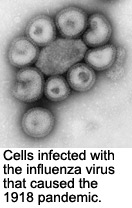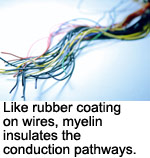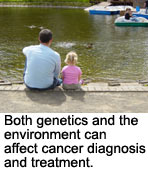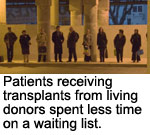May 2007
Inside this issue...
Research Breakthroughs
Mapping Human Leukemia in Mice
Influenza A Transmission
'Check'ing Out Cancer
Rebuilding Myelin in Spinal Cord Injury
Personalizing Cancer Treatment
Live Donor Transplants Cut Waiting Times
Breaking NewsDrug Interactions in Cancer
CFI Awards
Visit us at...
uhnresearch.ca
New Research Breakthroughs at UHN
 Cancer researchers led by OCI's Dr. John Dick have developed a method to convert normal human blood cells into “human” leukemia stem cells. The converted cells, when transplanted into special mice that permit the growth of human cells, can replicate the entire disease process from the very moment it begins.
Cancer researchers led by OCI's Dr. John Dick have developed a method to convert normal human blood cells into “human” leukemia stem cells. The converted cells, when transplanted into special mice that permit the growth of human cells, can replicate the entire disease process from the very moment it begins.
Explains Dr. Dick: “Most human leukemia research involves studying a patient's diseased cells or a cell line grown from those cells. However, since cancer takes many months or years to develop, just studying the cells at the end of the process does not let you know what the series of changes were that caused the cells to become leukemic, and when they happened.
“With the method we developed, we have duplicated the natural process every step of the way. It opens the pathway generally to understanding the process of how cancer begins."
Science. April 2007. Research was supported by the Canadian Institutes of Health Research, the Ontario Cancer Research Network, Genome Canada through the Ontario Genomics Institute, the Canada Research Chair, the Leukemia and Lymphoma Society, the National Cancer Institute of Canada, the Canadian Cancer Society and the Terry Fox Foundation.-
Influenza A: Getting a Handle on Transmission
 A new study from a UHN infectious disease expert may lead to improved methods for preventing transmission of the flu. Transmission of the influenza A virus can occur via multiple methods: direct physical contact with an infected individual; indirect contact through contaminated items; droplets generated during coughing/sneezing, talking or medical procedures; and airborne routes through droplets or dust particles.
A new study from a UHN infectious disease expert may lead to improved methods for preventing transmission of the flu. Transmission of the influenza A virus can occur via multiple methods: direct physical contact with an infected individual; indirect contact through contaminated items; droplets generated during coughing/sneezing, talking or medical procedures; and airborne routes through droplets or dust particles.
Through an extensive review of the research literature TGRI researcher Dr. Michael Gardam determined that the natural mode of transfer in humans is over short distances, likely via droplet and contact routes. The longer distance airborne route does not appear to be of clinical significance.
“In a situation like a pandemic, minimizing droplet and contact routes would be a great importance in clinical settings,” says Dr. Gardam. “Understanding previous research will help us reduce risk to health-care staff and patients.”
Lancet Infect Dis. 2007: 7: 257-65. [Pubmed abstract] Research was supported by the Emergency Management Unit of the Ontario Ministry of Health and Long Term Care.
-
Spinal Cord Injury: Rebuilding from the Ground Up
 A team led by Krembil researcher Dr. Michael Fehlings has demonstrated a new way to reconstruct an essential element in nerve function in the spinal cord in a paper jointly co-first authored by Drs. Eftekhar Eftekharpour and Soheila Karimi.
A team led by Krembil researcher Dr. Michael Fehlings has demonstrated a new way to reconstruct an essential element in nerve function in the spinal cord in a paper jointly co-first authored by Drs. Eftekhar Eftekharpour and Soheila Karimi.
A tissue called myelin functions as an insulating casing around nerve fibers and takes part in conducting signals from the brain to the rest of the body. After transplanting specific neural precursor cells (aNPCs) from the brain of adult transgenic mice into the spinal cords of mice which lack myelin, investigators were able to generate oligodendrocytes—the building blocks of myelin—which traveled down the spinal cord and formed mature myelin.
“This is a major step forward in spinal cord injury research,” says Dr. Fehlings. “The ability to restore the myelin insulation is a key component of a therapeutic strategy, and our study is the first to show this exciting result. Our future work will focus on generating neural precursor cells from alternative sources including embryonic stem cells and in applying this technology is concert with tissue engineering approaches to repair chronic spinal cord injury."
Journal of Neurosci. Mar 28, 27(13): 2416-28. [Pubmed abstract] Research was supported by the Canadian Institutes of Health Research, Stem Cell Network, CIHR New Emerging Team Grant in Regenerative Medicine and Nanotechnology, Ontario Neurotrama Foundation, the Christopher Reeve Paralysis and Sam Schmidt Paralysis Foundations.
- Lung Cancer: Customizing Patient Treatment
 New OCI research is shining light on genetic factors relating to treatment success in lung cancer, work which is fundamental to an emerging treatment strategy called “personalized” medicine.
New OCI research is shining light on genetic factors relating to treatment success in lung cancer, work which is fundamental to an emerging treatment strategy called “personalized” medicine.
The newest cancer therapies—so-called molecular targeted approaches —target specific molecules involved in cell growth, cell death and metastasis. Understanding how the therapy compounds interact with their targets—and the minor changes in targets that characterize individual cancers—is key to optimizing therapy for each individual patient.
A team led by UHN researcher Dr. Geoffrey Liu in collaboration with colleagues at Harvard University evaluated genetics and three specific forms of one such protein, EGFR, after treatment with an EGFR inhibitor. Molecular studies of the 92 patients showed that certain genetic variations in patients influenced clinical outcomes.
“We were able to correlate specific genetic variations of the EGFR gene with specific outcomes of treatment. This study offers strong support to the idea that increased focus on genetic and environmental factors is needed in cancer therapy response,” Says Dr. Liu.
Pharmacogenomics J. 2007 Mar 20; [Epub ahead of print]. [Pubmed abstract] Research was supported by the National Institutes of Health, the Doris Duke Charitable Foundation, the Kevin M Jackson Memorial Fund, and the National Cancer Institute.- Liver Transplant: Showing the Benefits of Live Donation
 TGH has been a world leader in liver transplants involving living donors, and a recent study has proven the beneficial effects of this treatment strategy. Living donation allows suitable recipients to avoid the long organ waiting list but may represent unknown immediate and long-term health risks given that recipients receive only part of a liver.
TGH has been a world leader in liver transplants involving living donors, and a recent study has proven the beneficial effects of this treatment strategy. Living donation allows suitable recipients to avoid the long organ waiting list but may represent unknown immediate and long-term health risks given that recipients receive only part of a liver.
To compare the risks of being on the list to those of receiving a living donation, UHN researchers Drs. David Grant, Gary Levy, Paul Greig, Ian McGilvray, Leslie Lilly, Nigel Girgrah, and Mark Cattral reviewed survival rates and mortality of patients in the liver transplant program.
They found that patients who received a right-lobe of a liver from a living donor had a higher survival rate post-transplant and reduced mortality on the waiting list than those who received a transplant from a deceased donor.
Says study leader Dr. Grant: “Live donor transplants significantly shorten wait times and reduce the chance of death for those patients who are on waiting lists. We have shown that we are able to help patients quicker and more effectively with live donation. Future studies will have longer follow-up times to more clearly understand the advantages and disadvantages of living donors.”
Am. J. Transplant. 2007; 7: 998-1002. [Pubmed abstract]Breaking News from UHN Research
-
Risk of Drug Interactions in Cancer Patients
Cancer patients are at an increased risk for potential drug interactions as found in a recent UHN study led by Dr. Monika Krzyzanowska.
For full coverage visit scientificamerican.com.
On the evening of April 24, 2007, UHN researchers Drs. John Dick (cancer stem cell properties), Tak Mak (the design of new tumour-targeting drugs), and Peter St George-Hyslop (diagnostic testing and repair methods for neurodegenerative diseases) were honoured with three of the four Premier's Summit Awards given to Ontario researchers to recognize their significant contributions to medical research.
For the full story visit UHN Research News.
- Krembil Research Institute Research Day June 18, 2007
Krembil is holding its annual Research Day at 89 Chestnut Street on Monday, June 18. This year's event will celebrate both basic and clinical research.
For information on abstract submission and/or registration, contact Crystal Leverman, Business Administrator, Krembil: cleverma@uhnresearch.ca
